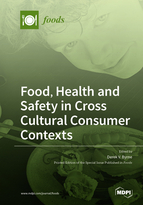Food, Health and Safety in Cross Cultural Consumer Contexts
A special issue of Foods (ISSN 2304-8158). This special issue belongs to the section "Sensory and Consumer Sciences".
Deadline for manuscript submissions: closed (31 December 2020) | Viewed by 63252
Special Issue Editor
Interests: sensory science; consumer science; food and beverage product quality; nutrition and eating; multisensory effects; crossmodal interactions; sensory methods; food uniqueness
Special Issues, Collections and Topics in MDPI journals
Special Issue Information
Dear Colleagues,
The global food and food technology market is in rapid growth, and food investment is central both in Eastern and Western governments’ growth plans. From a western perspective, the focus can be said to be on the food industry's ability to maintain and strengthen its position and exploit the unique opportunities for export-driven growth, especially in the export of high-quality food with health and sustainability as key elements. Eastern focuses are complementarily and synergistically focused on food safety, including health; food supply; as well as on unmet innovative solutions both in the organization and management of food supply chains and policies that regulate the food sector. Both sides can learn much from each other to ensure the smooth integration of goals and needs in the future of food business and research.
The present Special Issue’s focus is ‘Food, Health, and Safety in Cross-Cultural Consumer Contexts’ for innovative food solutions, to meet global food challenges, which can be best addressed by research-based synergies linking East and West in the food area.
In specific terms the Special Issue will encompass research on food science synergies for sustainable, healthy, and high-quality food supply, security, and consumption scenarios across the entire food chain from “farm to fork” in cross cultural contexts.
Specific areas of research relevant to this Special Issue are as follows:
- Food quality, processing, and production: focusing on understanding food processing, quality, and perception via a synergy of multisensory human food analysis, combined with novel and sustainable production techniques;
- Microbial food safety and hygiene: dealing with microbial food safety and focusing on means to detect food borne pathogens, sources of outbreaks of food borne diseases, and novel strategies to ensure food safety for the consumer;
- Food business, marketing, and the consumer: focusing on research on the development, marketing, and distribution of foods, to generate insight into consumer behavior for the benefit of food industries and public policy;
- Food economics and the supply chain: dealing with research in logistics and supply chain management regarding the concepts around economic thinking in food production, trade, and the management of food quality and safety across the supply chain;
- Food sociology and eating: the sociological elements of food safety and quality, including research around the social and cultural aspects of eating, production, and new technologies, as well as the role of legal frameworks and regulations.
- Nutrition and health: focusing on the effects on health of specific food, food components, and supplements in health and disease prevention, the rationale for nutritional recommendations, and food and nutrition security.
Both research papers, opinion papers, and review articles are welcome in this Special Issue of Foods, with a cross cultural topic as a requirement in the areas mentioned above.
Prof. Dr. Derek V. Byrne
Guest Editor
Manuscript Submission Information
Manuscripts should be submitted online at www.mdpi.com by registering and logging in to this website. Once you are registered, click here to go to the submission form. Manuscripts can be submitted until the deadline. All submissions that pass pre-check are peer-reviewed. Accepted papers will be published continuously in the journal (as soon as accepted) and will be listed together on the special issue website. Research articles, review articles as well as short communications are invited. For planned papers, a title and short abstract (about 100 words) can be sent to the Editorial Office for announcement on this website.
Submitted manuscripts should not have been published previously, nor be under consideration for publication elsewhere (except conference proceedings papers). All manuscripts are thoroughly refereed through a single-blind peer-review process. A guide for authors and other relevant information for submission of manuscripts is available on the Instructions for Authors page. Foods is an international peer-reviewed open access semimonthly journal published by MDPI.
Please visit the Instructions for Authors page before submitting a manuscript. The Article Processing Charge (APC) for publication in this open access journal is 2900 CHF (Swiss Francs). Submitted papers should be well formatted and use good English. Authors may use MDPI's English editing service prior to publication or during author revisions.
Keywords
- Food quality, processing, and production
- Microbial food safety and hygiene
- Food business, marketing, and the consumer
- Food economics and the supply chain
- Food sociology and eating
- Nutrition and health







